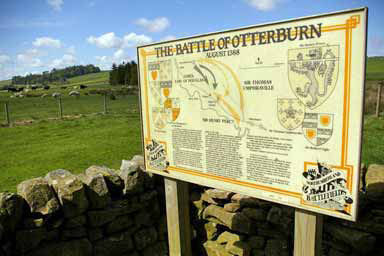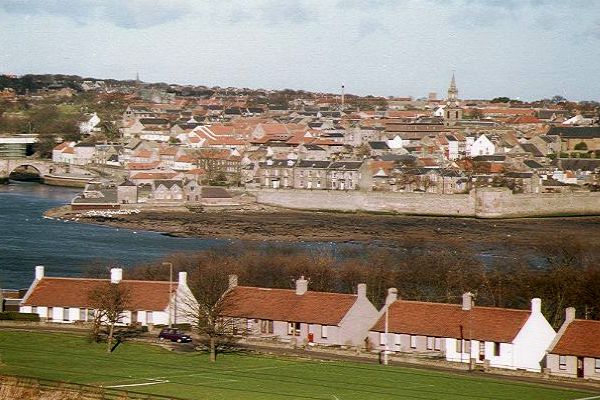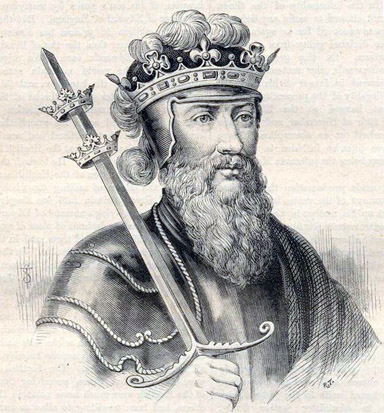
Border Battles and Conflicts
by Norman Turnbull
Turnbull Clan High Shenachie
Very few Border Battles have been recorded without one or more of the Turnbull’s being implicated and, indeed, when the occasion arose, the whole of the Turnbull Clan rallied to the Douglases, and their neighbours, in defending their country and their homeland, besides relishing any opportunity in battling with the “auld enemy” over the Border.

The battle of Otterburn on 19 August 1388 was one of the classic conflicts in the long feud between two of the most powerful of the Border families; the Percies on the English side and the Douglases on the Scottish side. Taking advantage of the fact that the English king Richard II was a minor, James, 2nd Earl of Douglas, led a raiding party into England in 1388.
The Scots reached Durham, which they burned and pillaged, but were held by an English army led by the Percies - Henry (nicknamed Hotspur) and his brother Ralph - in a skirmish outside Newcastle. During the skirmish, Douglas captured Hotspur’s lance pennon, his personal flag, and allegedly taunted him to recover it. For medieval knights this was regarded as a grave matter of honour and it was a challenge that Hotspur could not disregard.
Douglas left to return to Scotland, with the Percies in pursuit, and on his way back made an attempt to capture Otterburn Castle in Redesdale.
Douglas set up camp just to the West at Otterburn and waited for the Percies, thus virtually issuing an open invitation to Hotspur to attempt to recover his pennon. The English army arrived there in the evening of the 19th of August and Hotspur decided to surprise the Scots with a night attack. It was a risky strategy. The English army was inevitably tired after a long march while the Scots had been resting in camp for most of the day. In addition, the feared English archers, whose deadly longbow attacks were often the main reason for victory against the Scots, would be largely ineffective in night fighting.
Hotspur planed a two-pronged assault. While he advanced on Douglas’s men from the front, Sir Thomas Umftaville was sent on an outflank maneuver to the East and North of the Scots to attack them from the rear. The strategy did not work. The Scots took the initiative and, superbly led by Douglas, charged at the main English army. The fighting was fierce but the Scots were successful and both Hotspur and Ralph Percy were captured. Even the death of Douglas during the confused hand-to-hand fighting did not
weaken the Scottish resolve, as the Earl of Dunbar proved to be a more than adequate replacement. By morning, the battle was over and the Scots had gained a decisive victory.
Umfraville, who had taken virtually no part in the conflict, led the defeated English army back to Newcastle and the Scots, led by Dunbar, returned back over the Border. The Percies that were taken prisoners were later released.

The great siege of Berwick between the months of May to July in 1333 was probably the longest conflict the Turnbull clansmen found them selves involved in.
Berwick-upon-Tweed has seen many sieges throughout its history and the town changed hands between England and Scotland more than any other in the country -14 times - until finally remaining English in 1482. The Great Siege of 1333 was one of the longest, lasting three months.
After Robert the Bruce’s decisive victory over Edward II of England at Bannockburn in 1314, Scottish independence was safe for the time being and was officially recognised by Edward III at the treaty of Northampton in 1328. However, with the death of Robert the Bruce in 1329, the familiar problems reappeared. His successor, David II was only 5 years old and Edward Balliol, son of John Balliol, an English puppet who had ruled Scotland during the 1290s, returned from exile with an army. He was crowned king in 1332 but was soon ousted by Sir Archibald Douglas and the Earl of Moray. Balliol withdrew to the Borders where he sought help from Edward III. Naturally, the English king was only too delighted to assist.

In March 1333, Balliol laid siege to Berwick, which, at that time, was in Scottish hands. After about two months, Edward III and an English army joined him and in May the siege of Berwick began in earnest. Among the techniques used by the besiegers was an early form of biological warfare that comprised catapulting the severed heads of dead soldiers into the town in order to cause disease.
After nearly two months, Berwick’s defenses were crumbling and both besiegers and defenders were becoming frustrated. Eventually an agreement was made that there would be a truce and that if Berwick was not relieved within 15 days - by 11th July - the town would surrender to the English. This truce was guaranteed by 12 hostages and among these were the two young sons of Sir Alexander Seton, the deputy commander of the town. Scottish hopes depended on the arrival of reinforcements led by Sir Archibald Douglas. Douglas managed to send some supplies into the town but Edward III did not consider this sufficient to qualify as relieving it. In order to lure the besiegers away. Douglas then threatened to march south and pillage northern England.
Edward called his bluff. Gallows were erected as close to the walls of Berwick as possible and some of the hostages, including the two young boys, were hanged. A new and somewhat confusing agreement followed: There would be a further truce until 20th July and Berwick would surrender to the English if not relieved by then. The failure of Douglas to draw the English king away from Berwick by attacking Bamburgh and his crushing defeat at the Battle of Halidon Hill on the 19th of July sealed the town’s fate. On the following day, Berwick surrendered to the two Edwards, Edward III of England and Edward Balliol, the latter soon to be reinstated as King of Scotland.
After Douglas’s unsuccessful attack at Bamburgh, Douglas returned to Scotland and camped at Duns.
Meanwhile Edward III and the English army moved a short distance to the north and established themselves in a strong position on top of Halidon Hill.
Although the English had the better position, the Scots had the larger numbers as the English army had been weakened by desertions. Edward divided his army into three divisions; he commanded the centre, Sir Edward Bohun led the right wing and Edward Balliol led the left wing. The Scots were also organised into three divisions, led by the Earl of Moray, Robert the Steward and Sir Archibald Douglas.
As the Scots advanced across the very marshy ground at the base of the hill, their horses became bogged down, the cavalry troops had to dismount and they became sitting targets for the English and Welsh archers. Wave after wave of arrows descended on the slow moving Scottish soldiers and the subsequent English cavalry charge swept them from the field of battle and led to wholesale slaughter. One of the casualties was Douglas himself.
It was a crushing defeat for the Scots but for Edward III it was sweet revenge for his father’s humiliating defeat at Bannockburn. Berwick duly surrendered to the English, Edward Balliol was reinstated as king of Scotland and David II went into exile in France.
As an English puppet ruler, Balliol did his masters bidding and ceded Scottish territory to England, which hardly endeared him to his subjects. The Clan Turnbull bore heavy loses as did other Border Clans.
David II was to return later, seeking revenge.
